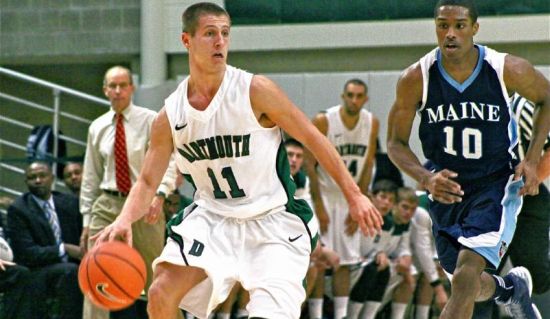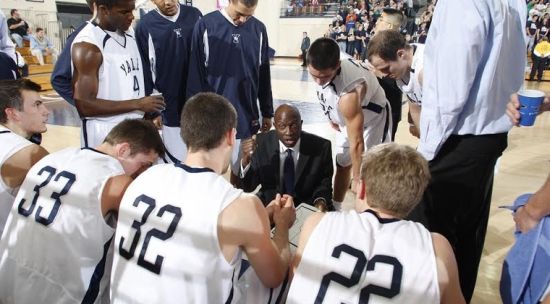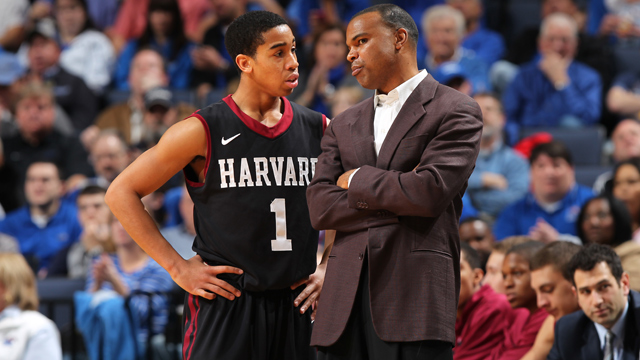Checking in on… the Ivy League
Posted by Michael James (@ivybball) on February 6th, 2015Michael James is the RTC correspondent for the Ivy League. You can also find his musings on Twitter at @ivybball.
Looking Back
- Home Unsweet Home – We’re over a quarter of the way through the 2015 edition of the 14-Game Tournament and an alarming trend just will not yield. Home teams are just 6-9 (0.400 – lowest of any conference in the nation) in league games thus far this season with both Cornell-Columbia and Harvard-Dartmouth splitting their travel partner series by winning on the other’s home floor. While Yale managed to sweep its travel partner showdown with Brown, it followed the same pattern, blowing out the Bears in Providence by 18 before trailing Brown at the final media timeout at home only to come back and win by four. The Ivies also rank last nationally in two other categories that many equate with a game’s appeal – offensive efficiency and percent of close games. Teams are scoring just 0.96 points per possession in league play (over five points per 100 possessions worse than the national average) and have combined for just two close games in 15 tries (13%).
- Channel Surfing – It took until just a couple weeks before the first back-to-back weekend in league play, but the Ivies finally locked down their television deal for the 2014-15 campaign. Five league games will be shown on CBS Sports Network, starting with Dartmouth’s visit to Yale this Friday, while another six will be shown on the American Sports Network, which is a syndicated network, using deals with other stations to carry its product to market. While the deal was a late victory to keep Ivy games on television after the NBC Sports Network deal expired last season, neither of the league’s two marquee matchups between Harvard and Yale will be featured on CBS Sports Network and the first meeting this Saturday will be relegated to Ivy League Digital Network.
Reader’s Take
Power Rankings
- Yale (15-6, 4-0 Ivy) – After a rough end to the non-conference slate saw the Bulldogs drop three of four tight contests, Yale has taken three-straight games in league play – all of which were within a possession or two after the final media timeout. More importantly, though, the Bulldogs have already survived three of their seven league road games and now get six of their next eight at home, as they attempt to put the title chase out of reach before visiting Harvard in the season’s penultimate game. While the 4-0 Ivy start has been impressive, there are some underlying concerns. Yale has allowed opponents to shoot 37 percent of their shots from three and has benefited from an unsustainable opposition hit rate of just 27 percent. Also, the Bulldogs are doubling up their opponents on free throw rate – a metric that was far less lopsided in non-league play. Yale is getting 31 percent of its points in Ivy play from the free throw line, which would be tops in the nation and a greater than four-standard deviation outlier if it occurred over the whole season.
- Harvard (13-5, 3-1) – A road map to exit the offensive wasteland in which it had been mired for most of December and January finally seems to be materializing for the Crimson. For most of his tenure at Harvard, coach Tommy Amaker has had the talent to run his motion offense, which requires constant movement on and off the ball with all five players looking to put themselves into scoring position at all times. What Amaker has found out this season is that the motion offense bogs down a lot when the players on the floor have fewer and fewer spots from which they can be successful offensively. During its road sweep of Penn and Princeton, however, Amaker showed off his modifications to the motion offense with some success: pushing the offense to look for opportunities earlier, assigning roles to players like defensive specialist Agunwa Okolie that would put them in a position to succeed offensively and doling out more minutes to offensively-oriented players like Corbin Miller and Jonah Travis to jumpstart things on that end.
- Princeton (9-10, 2-1) – If there’s a sneaky team that could break up what appears to be a two-horse race for the title, it’s Princeton. The Tigers offense has quietly become quite efficient and its defense, which dogged it throughout the non-league slate, has looked much better in Ivy play. Opponents are struggling to find open threes (lowest attempt rate allowed in Ivy play) and connect passes for buckets (lowest assist rate allowed in league play). That’s the good news. The bad news is that the schedule turns violently against the Tigers over the next eight games, including six road contests and a visit from league-leading Yale. First up is the Cornell-Columbia road swing, which Princeton must at least split in order to get its chance to insert itself in the title chase hosting the Bulldogs the following Saturday.
- Columbia (10-8, 2-2) – The Lions are getting 44 percent of their points in Ivy play from three pointers on a hit rate that is just north of 40 percent. And still their offensive efficiency rating in league play is a couple points below the national average. That means that not only will other aspects of the offense have to improve to propel Columbia forward, some of that improvement will have to happen just to cover the likely regression in the Lions’ three-point shooting. Columbia has seen 18 percent of its two-point attempts get blocked in Ivy play, but that has come against some of the more stout frontcourts in the league (Cornell twice, Yale and Brown). With Penn and Princeton paying a visit this weekend – two teams that are not nearly as prolific at blocking shots – the Lions might finally be able to get a boost from points in the paint.
- Cornell (10-10, 2-2) – Big Red opponents have posted the following points per possession outputs over the first four games of Ivy play: 0.76, 0.87, 0.78 and 0.97. To put those numbers in perspective, Cornell has handed Columbia its two worst offensive efficiency showings of the season, Brown its second-worst and Yale its fourth-worst. The Big Red’s own offense has been similarly and alarmingly bad, however. Cornell joins Dartmouth and Penn in a fight for the least efficient offense in league play – with all three hovering around 0.87 to 0.88 points per possession. While the Big Green and Quakers are hanging around the offensive basement due to the usual suspect – an elevated turnover rate – the Big Red actually leads the league in avoiding turnovers. That could be a sign of better things to come for Cornell, though. It is a distant last in shooting percentage, which is something that should naturally start to rise, and when it does, paired with a strong Big Red defense, Cornell could push its way into the league’s upper division.
- Dartmouth (8-10, 1-3) – If it wasn’t for a brilliant 10-minute stretch at Harvard, the narrative surrounding the Big Green could be quite different. Reserve point guard Malik Gill has been a sensation for Dartmouth, spurring the team force turnovers on 27 percent of opponents’ possessions in league play – the only one of the four factors on either side of the ball in which the Big Green ranks higher than fourth in the eight team league. There’s reason to believe that Dartmouth is suffering from a little bad luck, as opponents are shooting 52 eFG percent in league play after the Big Green ranked above average nationally (over four percentage points better) in that metric during the non-league slate. As that regresses, it will help carry an offense that was below average in every facet of the game coming into league play and hasn’t improved since.
- Penn (6-11, 1-2) – A little momentum appeared to be building after a surprising upset of Big 5 rival St. Joseph’s and a home victory over Dartmouth to even its Ivy League record. Then the Quakers showed everyone why they will likely be relegated to the league’s lower division for the third-consecutive year and fifth time since winning their last Ivy title in 2007. In the 63-38 pasting by Harvard, Penn threw the ball away on many occasions, shot just 8-for-17 from the line and a woeful 35 percent from the field. In consecutive 10-minute spans, the Quakers scored nine points, six points, 12 points and 11, though 8 of those final 11 points came in the final three minutes after Harvard had emptied its bench. The frequent scrums were an eyesore and seemed to be a product of a team predisposed to match every step forward with two in the opposite direction. With five more Ivy home games and an offense that can be productive when it remains disciplined, Penn should cobble together a handful of league wins, but that won’t be enough to avoid a very difficult decision from new Athletic Director Grace Calhoun this offseason.
- Brown (9-12, 0-4) – The victory over a Providence team that seems poised to make the NCAA Tournament will always be an amazing highlight in what has otherwise been a very difficult season. Things went from bad to worse for the Bears last week after Brown announced that sophomore Leland King, Brown’s leading possessions user, was leaving the program. Against Division I competition this year, the Bears are 7-7 with King and 0-5 without him. Despite the latter mark, Brown has fought hard in all five losses, including playing league-leading Yale even for over 39 minutes on the road before falling 69-65. With two frontcourt anchors in Rafael Maia and Cedric Kuakumensah and a handful of guards who aren’t shy about launching threes, Brown has the recipe for pulling upsets down the stretch. The bench is extremely thin now, though, and the Bears have been outscored by 38 points combined in the second half of their last three games.

Things haven’t been great this year for Alex Mitola and Dartmouth, but they did pick up a huge win against Harvard. (Valley News)
Top Game
- Dartmouth 70, Harvard 61 – Siyani Chambers had worked himself into a tricky spot on the corner baseline, but manage to swing a skip pass to a wide-open Wesley Saunders just behind the three-point arc. It was a shot that Saunders had to take, and given the way things were going, it was no surprise it went in, handing the Crimson a 43-29 lead with just 13 minutes to play. Harvard then proceeded to miss three treys, three jumpers, two free throws and a layup before finally scoring again, while Dartmouth scored on six of its next eight possessions to rip off a 14-0 run that knotted the score with just under eight minutes left. The Big Green wasn’t close to finished either. After Harvard broke the streak, Dartmouth rattled off another 12-0 stretch to post a 26-2 run that took it from down 14 to up 10 in a 10-minute span. There would be no furious comeback for the Crimson as there had been two years earlier, as Dartmouth salted the game away at the free throw line to beat Harvard for the first time since 2009.
Looking Ahead
- Friday, February 6 – Princeton at Columbia, 7:00 PM, ESPN3/WatchESPN – After a promising non-conference slate, the Lions face a veritable Ivy elimination game in hosting the Tigers. Columbia coach Kyle Smith has only beaten Princeton once since taking over in the 2010-11 season. The matchup will be strength-on-strength as the Lions three-point shooting attack goes up against a Tigers squad that prides itself on chasing opponents off the three-point line.
- Saturday, February 7 – Harvard at Yale, 7:00 PM, Ivy League Digital Net – Assuming both teams hold serve on Friday night as heavy favorites, the Crimson and Bulldogs will meet in a clash that will dramatically change the narrative for the second half of the league slate. A Yale win to cap off a home sweep of Dartmouth and Harvard would put it two games up on the Crimson and likely two games up on the rest of the field as well with just eight games to play. A Harvard victory would leave it pretty much exactly where it expected to be after a tough six game stretch to open the league campaign and would put it back in the driver’s seat for the league title. Kenyatta Smith returning for Harvard will be critical against Yale, as the Bulldogs have owned the paint in Ivy play and the Crimson will need as many big bodies as possible to stop them.
- Friday, February 13 – Columbia at Harvard, 6:00 PM, CBS Sports Network – If Columbia can pull off the home sweep of Princeton and Penn, it will earn the chance to take on Harvard as a legitimate factor in the Ivy title race. The Lions should be able to play enough defense to hang around with the Crimson, but if they don’t shoot the three ball well, they probably won’t be able to muster enough offense against the stout Harvard D for that to matter.











































